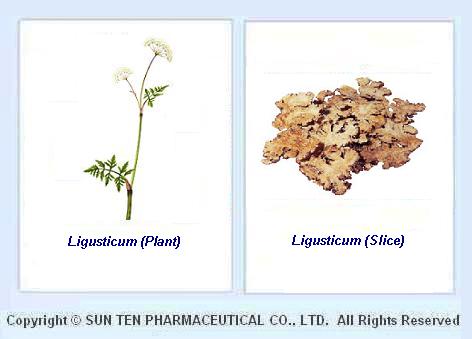Ligusticum (Rhizoma Chuanxiong; Chuan Xiong)
TCM Herbal Story
Ligusticum (Rhizoma Chuanxiong; Chuan Xiong)
According to legend, the medicinal expert Sun Si Miao and his apprentice travelled to Mt. Qingcheng, Sichuan, during the early years of Tang dynasty. One day, while Sun and his apprentice were resting in the Qingsong forest, they saw a big female crane and several baby cranes playing in the stream. After a while, they began to hear continuous scream coming of the baby cranes, and found that the big female crane had bent her head down with both legs shivering. Judging from what he had seen, Sun believed that the female crane was coming down with an acute disease.
The next morning, Sun and his apprentice returned to the forest to look for the sick crane. They easily identified the nest from her loud cry. Shortly after their arrival, they saw several white cranes coming down from the sky and started to toss leaves into the nest. Sun’s apprentice picked a couple of the leaves from the ground out of curiosity, but quickly threw it back after finding that the leaves resemble to that of carrots. However, Sun ordered his apprentice to pick the leave up again for reference.
On the third day, Sun and his apprentice visited the forest again for the sick crane. Strangely, they saw the same white cranes from yesterday circling above the nest of the sick crane. Instead of dropping leaves into the nest, they dropped some small white flowers. Again, Sun ordered his apprentice to pick a few samples of the flower.
On the fourth day, Sun discovered that the sick crane had recovered and was out playing with the baby cranes. He also noticed that the mysterious white cranes stayed a great deal amount of time in a cave near Hun Yuan Ding cliff. Inside the cliff, there was a large green field of unknown plants, with leaves and flowers resemble to what the white cranes had dropped.
Sun suspected that the recovery of the sick female crane must have some kind of connection with the plant. He believed that the plant had the ability to activate the blood and meridian, dispel the wind, and relieve pain. Therefore, Sun took some samples before leaving and started to use it for his patients. With more and more satisfactory results reported from his patients, he named the plant Chuan Xiong, meaning the sky of Sichuan, as the herb were dropped by the cranes in the sky.
Ligusticum is the rhizome of Ligusticum chuanxiong Hort. Its properties are acrid and warm. It enters through the liver, gallbladder, and pericardium.
Actions & Indications:
- Invigorates the blood and promotes the movement of qi
- Expels wind and alleviates pain
- Headaches
Caution & Contradiction
- Contraindicated in cases of yin deficiency with heat signs, headaches due to ascendant liver yang, qi deficiency, or excessive menstrual bleeding. Vomiting and dizziness may occur from overdosage.
- According to some traditional texts, this herb antagonizes Fructus Corni officinalis (Shan Zhu Yu) and Radix Astragali membranaceus (Huang Qi), counteracts Talcum (Hua Shi) and Rhizoma Coptidis (Huang Lian), and is incompatible with Rhizoma et Radix Veratri (Li Lu).
The original article is from Brion Research Institute, translated by Sun Ten Pharmaceutical Co., Ltd.
For Chinese/original version, please go to:
